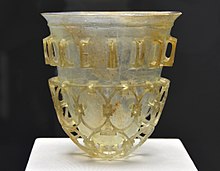Kaca Romawi
Objek-objek kaca Romawi diangkat di sepanjang kekaisaran Romawi dalam konteks domestik, industrial dan pemakaman. Kaca biasanya digunakan untuk membuat barang-barang hias, meskipun genting mosaik dan kaca jendela juga dibuat. Pembuatan kaca Romawi berkembang dari tradisi teknikal Helenistik, yang awalnya berkonsentrasi pada produksi barang-barang kaca berwarna. Namun, pada abad ke-1 Masehi, industri tersebut bertumbuh cepat dengan pengenalan penggelembungan kaca dan dominasi gelas bening atau tak berwarna. Produksi kaca mentak dilakukan untuk mengerjakan kaca menjadi barang-barang hias di lokasi terpisah,[1][2] dan pada akhir abad ke-1 Masehi, pembuatan skala besar diakibatkan karena penggunaan kaca sebagai material yang umum yang tersedia di dunia Romawi, dan juga memiliki teknik yang sangat sulit khususnya gaya-gaya kaca mewah, yang harus sangat menghabiskan banyak biaya.

Referensi
suntingDaftar pustaka
sunting- Allen, D., 1998. Roman Glass in Britain. Princes Risborough, Buckinghamshire, Shire Publications.
- Amrein, H.,2001, L'atelier de verriers d'Avenches. L'artisanat du verre au milieu du 1er siècle après J.-C., Cahiers d'archéologie romande 87, Lausanne 2001.
- Baxter, M. J., H. E. M. Cool, et al., 2006. Comparing glass compositional analyses. Archaeometry 48/3, 399-414.
- Biek, L. and J. Bayley, 1979. Glass and other Vitreous Materials. World Archaeology 11, Early Chemical Technology/1, 1-25.
- Brill, R. H., 1999. Chemical Analyses of Early Glasses. New York, Corning Museum of Glass.
- Caldera de Castro, M. d. P., 1990. Roman glass in southwest Spain. In Annales du 11e Congres. Amsterdam.
- Caron, B., 1993. A Roman Figure-Engraved Glass Bowl. Metropolitan Museum Journal 28, 47-55.
- Dussart, O., B. Velde, et al., 2004. Glass from Qal'at Sem'an (Northern Syria): The reworking of glass during the transition from Roman to Islamic compositions. Journal of Glass Studies 46, 67-83.
- Evison, V. I., 1990. Red marbled glass, Roman to Carolingian. In Annales du 11e Congres. Amsterdam.
- Facchini, G. M., 1990. Roman glass in an excavational context: Angere (VA). In Annales du 11e Congres. Amsterdam.
- Fleming, S. J., 1999. Roman Glass; reflections on cultural change. Philadelphia, University of Pennsylvania Museum of Archaeology and Anthropology.
- Forbes, R. J., 1966. Studies in ancient technology V. Leiden, Brill.
- Freestone, I. C., 2005. The provenance of ancient glass through compositional analysis. Materials Issues in Art and Archaeology 7.
- Freestone, I. C., 2006. Glass production in Late Antiquity and the Early Islamic period: a geochemical perspective. Geomaterials in Cultural Heritage: Geological Society of London. Special publication 257: 201-216.
- Freestone, I. C., M. Ponting, Hughes, M.J., 2002. Origins of Byzantine glass from Maroni Petrera, Cyprus. Archaeometry 44, 257-272.
- Grose, D. F., 1991. Early Imperial Roman cast glass: The translucent coloured and colourless fine wares. Roman Glass: two centuries of art and invention. M. Newby and K. Painter. London: Society of Antiquaries of London.
- Gudenrath, W., 2006. Enameled Glass Vessels, 1425 BC - 1800: The decorating Process. Journal of Glass Studies 48, 23.
- Jackson, C. M., H. E. M. Cool, Wager, E.C.W., 1998. The manufacture of glass in Roman York. Journal of Glass Studies 40, 55-61.
- Price, J., 1990. A survey of the Hellenistic and early Roman vessel glass found on the Unexplored Mansion Site at Knossos in Crete. Annales du 11e Congres. Amsterdam.
- Rutti, B., 1991. Early Enamelled Glass. In M. Newby and K. Painter (eds.) Roman Glass: two centuries of art and invention. London: Society of Antiquaries of London.
- Silvestri, A., G. Molin, et al., 2005. Roman and medieval glass from the Italian area: Bulk characterization and relationships with production technologies. Archaeometry 47/4, 797-816.
- Stern, E. M., Roman Mould-blown Glass. Rome, Italy: L'Erma di Bretschneider in association with the Toledo Museum of Art.
- Stern, E. M., 1991. Early Exports Beyond the Empire. Roman Glass: two centuries of art and invention. M. Newby and K. Painter. London: Society of Antiquaries of London.
- Stern, E. M., 1999. Roman Glassblowing in a Cultural Context. American Journal of Archaeology 103/3, 441-484.
- Stern, W. B., 1990. The composition of Roman glass. In: Annales du 11e Congres. Amsterdam.
- Velde, B., Year. Observations on the chemical compositions of several types of Gallo-Roman and Frankish glass production. In: 9e Congres International d'Etude Historique du Verre, Nancy, France: Editions du Centre de Publications de L'A.I.H.V.
- Whitehouse, D., 1990. Late Roman cameo glass. In: Annales du 11e Congres. Amsterdam.
- Whitehouse, D., 1991. Cameo Glass. Roman Glass: two centuries of art and invention. M. Newby and K. Painter. London: Society of Antiquaries of London.(UK)